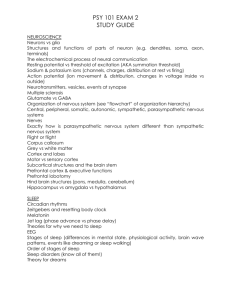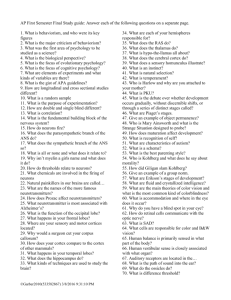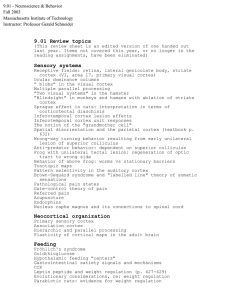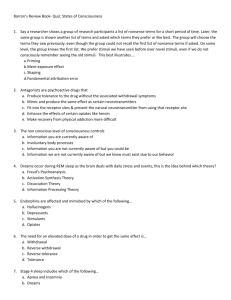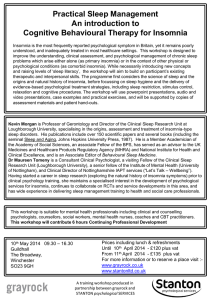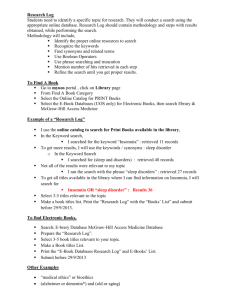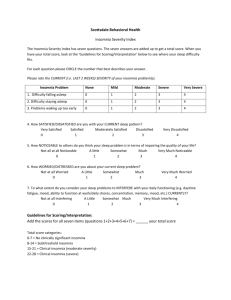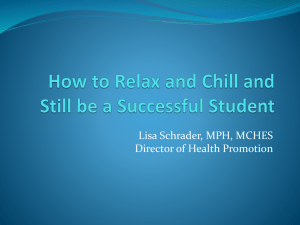Barry Jacobs presentation
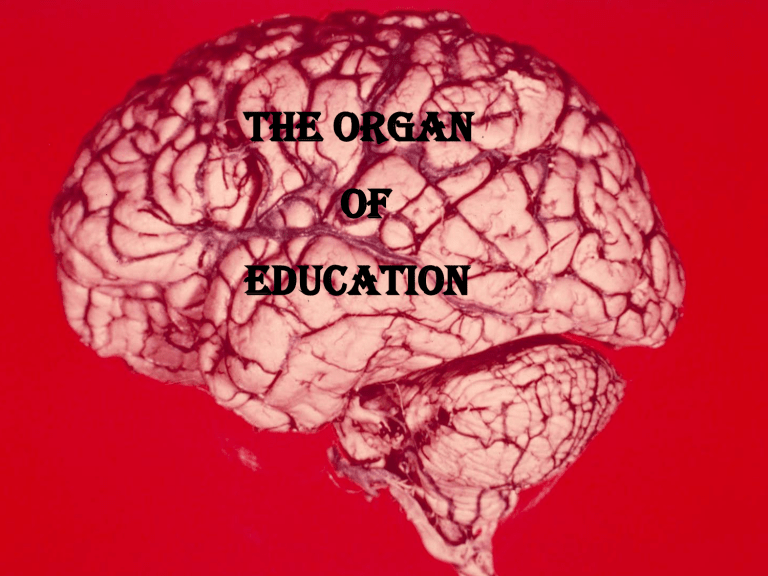
THE ORGAN of
EDUCATION
What % Of Our Brain Do We Typically Use?
(let’s have a show of hands)
10%
30%
50%
80%
!00%
How many of you believe that you mind is
COMPLETELY contained within or
COMPLETELY controlled by the 3.5 lb. of gray mush that lies within your skull?
MIND
• Is the mind a manifestation of brain function? If not, what is it?
• If it is, then it is the manifestation of physico-chemical components. How is this different than a rock, a computer? Do computers think? Do they have free will, consciousness, and emotion?
• Could we build a machine with the same physicochemical components of our brain that would have a mind? Why not?
THIS PROFESSOR’S GOT A BRAIN!!!
PAUSE
for
DISCUSSION
Learning
(or behavioral plasticity) – the acquisition of a reversible change in behavior resulting from experience (consciously or unconsciously)
Memory
– the process by which we retain knowledge over time.
DEVELOPMENT
Surface of Brain
Development of Dendritic Growth in Human Visual Cortex
NEWBORN 3 MONTHS 2 YEARS
Genes may instruct overall structure, such as what layer of cortex (I – VI) a cell should migrate to, but not the billions of synaptic connections (determined by use and experience)
EAT, SLEEP, INFREQUENTLY AWAKE FOR LONG PERIODS
CRITICAL PERIODS
• There are times during development when conditions must be right or it may be difficult or impossible to correct them later.
• A young child who is abused or neglected may have great difficulty in successfully navigating adult social life.
• If not corrected early on in life an infant with cataracts or “lazy eye” may grow up to have imperfect vision.
USE IT OR LOSE IT!
Two of the major processes in the developing brain
1. Pruning of axons and dendrites
2. Cell death (APOPTOSIS programmed cell death – can be caused by gene activation)
QUESTIONS?
Plasticity
An important catchall that covers all of experience-induced changes in brain.
It is critical to appreciate the fact that all areas of the brain can show plasticity, and that all that you experience alters your brain!
Granule cell layer of the
Dentate Gyrus
OUTPUTS
INPUTS
THIS PROCESS TAKES WEEKS – THERAPEUTIC LAG?
Gage Lab
Bromodeoxyuridine is used to replace thymidine
This process declines dramatically in the aged
Effects of Insomnia
Insomnia (lack of sleep or frequent sleep interruption) can produce or exacerbate physical and psychological ailments (it exerts negative effects upon the immune system).
I strongly believe that there is a bidirectional relationship between CLINICAL DEPRESSION and insomnia.
Hippocampal
Regions
Posterior
Control Sleep Deprivation (SD) SD+Recovery
1719.6
±152.4
948.8
±76.8
⁎⁎ (−44.8%) 914.4
±198.0
⁎ (−46.8%)
SLEEP IS IMPORTANT FOR
LEARNING AND MEMORY
During sleep, the brain appears to reactivate or
“replay” the pattern of neuronal activity of the initial exposure to the material to be learned.
A SMALL SAMPLE OF FACTORS
AFFECTING ADULT BRAIN NEUROGENESIS
INCREASE
Exercise
Exploration
Learning
Estrogen
Brain Damage
DECREASE
Adrenal hormones
Predator Odors
Stressors
Sleep Loss
Auditory cortex of accomplished musicians is 130% larger than that of control subjects
Representation of fingers 2-5 of the
left hand in somatosensory cortex
of violinists is larger than that of their right hand
EPIGENETICS
Heritable changes in gene expression caused by mechanisms other than changes in the underlying DNA sequence. They may remain through cell divisions for the remainder of the cell's life and may also last for generations.
As an example, abuse of an infant may change her gene expression and this may be manifested in adulthood (e.g.
psychopathic personality). AND, this may be transmitted across the next generation to her own children.
Think of the implications of this for education.
PAUSE
FOR
DISCUSSION
LEARNING
&
MEMEORY
DENDRITE
1.
AXON
1.
2.
NEUROTRANSMITTER
SYNAPSE e.g. cyclic AMP, formed when a
G-protein is activated and converts ATP to c-AMP, goes on to activate specific proteins
(esp. kinases)
NUCLEUS
Memory is mental time travel. It allows us to go back in time to relive the moment. If memories are not strung together in a meaningful and coherent fashion, it’s like looking at someone else’s family photos
.
Long-Term Storage of Information
• Complex experience activates numerous areas of neocortex
• These areas activate hippocampus
• In turn, hippocampus “binds” these cortical areas
• These cortical areas now act autonomously and in concert to generate long term memory
Auto Accident
A MAJOR PUZZLE!
?
MOTOR
(M)
*
AUD
(A)
SOMAT
(S)
A synapse that increases its effectiveness because of simultaneous activity in the pre – and post-synaptic neurons is called a Hebbian synapse (*).
S can activate M but A alone can ’t. But if A & S fire together, then the connection between M & A is strengthened.
NO = nitric oxide
NO
NO
1
MONOAMINE TERMINAL
2
3
Release of glutamate stimulates NMDA receptors, and the resulting influx of CA2+ activates nNOS.
NO synthesized by the enzyme spreads over in a sphere and reaches monoamine terminals. NO inhibits the function of transporters (T), which increases monoamine concentrations.
Episodic Semantic
Further Division of Declarative Memory
• Spatial -- location
• Factual or Semantic --words and their meaning, people, faces, objects, concepts – all in discrete categories. FACTS
• Episodic -- “snapshots” of life events. Typically of important events.
BELL &
FOOD
BAR &
PRESS
